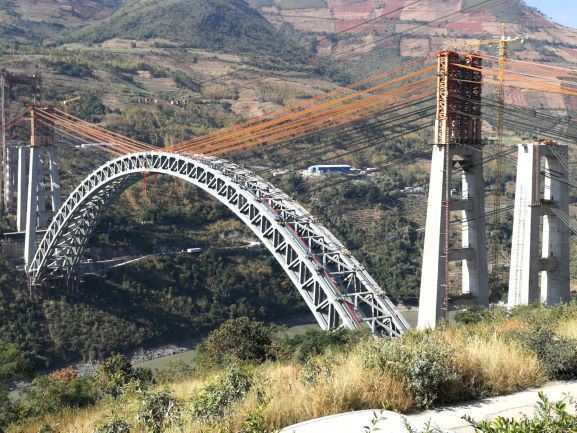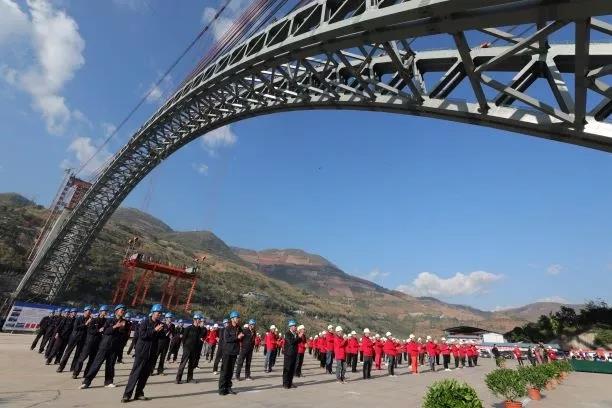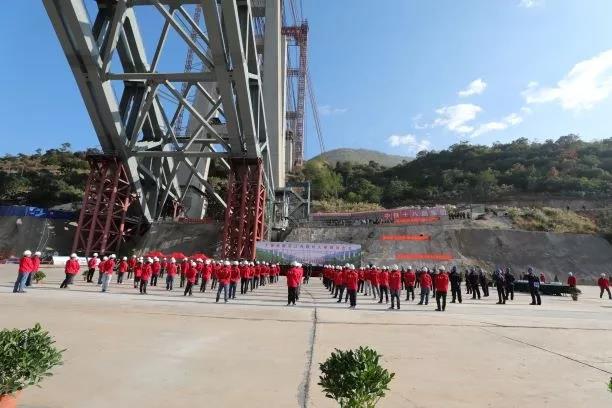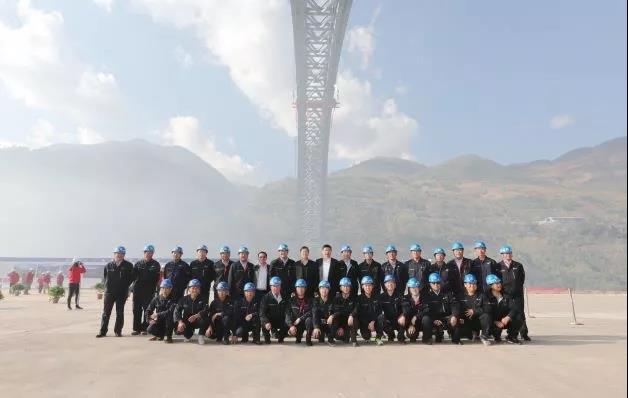At 11 a.m. on 10th Dec., with the last piece of steel truss arch being fixed in place, closure work of Nujiang Grand Bridge on Dali-Ruili Section of China-Myanmar international railway concluded successfully, marking a significant progress in constriction of major structure of the Grand Bridge and laying a solid foundation for on-schedule completion of Dali-Ruili Section of China-Myanmar international railway. The Grand Bridge, crossing over the Nujiang River like a rainbow, is constructed by China Railway 18th Bureau, and China Railway Baoji Bridge Group (CRBBG) has participated in its construction.

Nujiang Grand Bridge, located in the border between Shidian County and Longling Country of Baoshan City in Yunnan Province, is currently the longest in span of its kind worldwide. Its total length is 1024.2 meters, the height between its surface and the river surface is 211 meters, and its main span is made up of steel truss arches spanning 490 meters. In this super engineering construction, CRBBG undertook the manufacture, erection and installation works of over 46,000 tons of steel truss arches, steel truss girders and steel posts.

According to Li Zongmin, the general manager from CRBBG, the railway station is rightly set on the four-line bridge deck that is 24.9 meters wide because of the restrictions brought by the special landforms of Gaoligong Mountain and Nujiang River, an indeed rare arrangement among the domestic railway bridges. Meanwhile, with the Grand Bridge located in the strong seismic belt, strong wind prevailing in the gorge and along the river course all year round, and the heavy operational load and long span truss arch of the bridge itself, the engineering has met with domestically rare technical difficulty and construction risk, and it is rated as one of the dominant works in constructing Dali-Ruili Railway. In response, CRBBG has given high attention, prepared elaborate plan, and established a special project team led by the company’s leaders and composed of elites from technology, management and production departments to manage all the works relating to production and construction of the bridge.

Fabrication, transport of work pieces, erection and installation of the superlarge span and deck-type steel truss arches which have a total amount of 40 sections and parts and a total weight of 27,000 tons is the most essential and crucial work in the bridge construction. “For more than two years, we have employed BIM (Building Information Modeling) technology for the first time in China in order to guarantee the right precisions of multidimensional angles in spatial structure of steel truss arches and the main truss rods and achieved data-based overall monitoring in instructing construction works by advanced simulation of construction procedures of all processes through three-dimension animation of the engineering, have formed a production and organization mode of “one bridge and five sites” and worked out a mountain road transport plan for rods of oversize, overlength and overweight after continuously innovation in production and organization mode and way of transport for rods of oversize, overlength and overweight, making us complete production, transport and installation works of all the steel truss arches before the scheduled time; and particularly, have achieved a major technological breakthrough of joining up four pieces of main trusses of the steel arch bridge simultaneously for the first time in the country in the construction process of closure of steel truss arches, providing a reference and solution to bridge construction of similar kind in the future”, said Hou Yinghui, the Deputy Secretary of CPC from CRBBG and Manager of Nujiang Bridge Project.

The total length of China-Myanmar international railway from Kunming to Yangon, Myanmar is 1,920km, and the part in China’s territory is 690km. So far, the 350km Kunming-Dali section has been constructed, and the Dali-Ruili section which is 340km long is under busy construction. If the line is fully opened, the travel time from Dali to Ruili will be reduced to over 2 hours from the current 7 hours, and people in Southwestern Yunnan will say farewell to the no-railway history.
